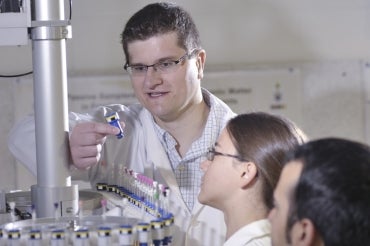New U of T research looks at the impact of environmental toxins at the molecular level

Published: February 28, 2017
New research to develop cutting-edge technology that can shed light on the impact of contaminants at the molecular level just received a funding boost.
The research, led by Andre Simpson, professor of physical and environmental sciences at U of T Scarborough, received funding from the Natural Sciences and Engineering Research Council of Canada’s Strategic Partnership Grant program.
Simpson says while current technology can tell us to what degree a contaminant is lethal, it’s not sensitive enough to effectively monitor the impacts of the chemical at the molecular level and explain why it is toxic.
“If a chemical has a subtle impact, that is to say it’s not lethal right away but makes us sick, it can be arguably more hazardous, to animal, plant and human populations. These chemicals are often only detected too late, and only after physical symptoms become widespread,” he says.
Simpson is one of six researchers across U of T to receive funding through the Strategic Partnership Grant program, which seeks to support collaborations between the research community, industry and government organizations. More than $2.6 million in funding was given to U of T researchers including Assistant Professor of Chemical Engineering and Applied Chemistry Ya-Huei (Cathy) Chin, Physics Professor Robin Marjoribanks, Ecology and Evolutionary Biology Professor Donald Jackson, Materials Science and Engineering Professor Uwe Erb, and Electrical & Computer Engineering Professor Shahrokh Valaee.
Simpson’s team is developing new technology called a digital microfluidics-microcoil NMR – think of it as a chemistry lab on a tiny microchip. Each microcoil is about 20 microns in size, which is tiny compared to the typical width of a human hair, which is about 40 to 50 microns. The chip is able to grab water droplets, move them around and can also mix chemicals to monitor how even tiny organisms like Daphnia react to various contaminants.
While NMR is used extensively in medical research, Simpson’s lab at U of T Scarborough is the only one in North America dedicated to purely environmental research.
“It’s no longer good enough to say that a substance is toxic. We need to know what it’s doing to us, and to measure this, we need new technology that can measure the impacts of a living system to its surrounding in real-time and with high molecular resolution.”
Since the new technology being developed relies on Nuclear Magnetic Resonance (NMR) spectrometers, it’s powerful enough to see the complete molecular makeup and interpret how specific molecules in various toxins affect living organisms in real time.
Simpson points to the ability to be able to monitor a change in amino acids, sugars, DNA or other complicated bio-chemical processes in the body in real time as a prime example of the technology’s potential.
“If something is causing amino acids or sugars to rise, and those levels don’t return to equilibrium, we can show that a permanent change in biochemistry took place. That’s where we can set evidence-based policies around chronic exposure,” he says.
In addition to collaborating with U of T Chemistry Professor Aaron Wheeler, who developed the digital microfluidics-microcoil technology, Simpson is also partnering with Bruker BioSpin, a scientific instruments company that specializes in developing NMR technology.



